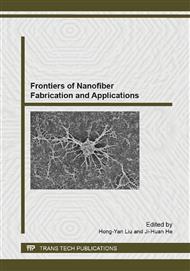[1]
R. Gentsch, B. Boysen, A. Lankenau, H.G. Borner, Single-step Electrospinning of Bimodal Fiber Meshes for Easa of Cellular Infiltration, Macromol. Rapid Commun. 31 (2000) 59-64.
DOI: 10.1002/marc.200900431
Google Scholar
[2]
M.S. EI Naschie, Nanotechnology for the developing world, Chaos Soliton Fract. 30 (2006) 769–73.
Google Scholar
[3]
J.H. He, Y.Q. Wan, L. Xu, Nano-effects, quantum-like properties in electrospun nanofibers, Chaos Soliton Fract. 33 (2007) 26-37.
DOI: 10.1016/j.chaos.2006.09.023
Google Scholar
[4]
J.H. He, An elementary introduction to recently developed asymptotic methods and nanomechanics in textile engineering, Int. J. Mod. Phys. B. 22 (2008) 3487–3578.
DOI: 10.1142/s0217979208048668
Google Scholar
[5]
L. Xu, L. Wang, N. Faraz, A thermo-electro-hydrodynamic model for vibration-electrospinning process, Therm. Sci. 15(S) (2011) S131-S135.
DOI: 10.2298/tsci11s1131x
Google Scholar
[6]
J.H. He, Effect of temperature on surface tension of a bubble and hierarchical ruptured bubbles for nanofiber fabrication, Therm. Sci., 16 (2012),325-328.
DOI: 10.2298/tsci111111033h
Google Scholar
[7]
F. Yang, R. Murugan, S. Wang, S. Ramakrishna, Electrospinning of nano/micro scale poly(l-lactic acid) aligned fibers and their potential in neural tissue engineering, Biomaterials. 26 (2005) 2603-2610.
DOI: 10.1016/j.biomaterials.2004.06.051
Google Scholar
[8]
B. Ding, M.R. Wang, J.Y. Yu, G. Sun, Gas Sensors Based on Electrospun Nanofibers, Sensors. 9 (2009) 1609-1624.
DOI: 10.3390/s90301609
Google Scholar
[9]
A.C. Patel, S.X. Li, C. Wang, W.J. Zhang, Y. Wei, Electrospinning of Porous Silica Nanofibers Containing Silver Nanoparticles for Catalytic Applications, Chem. Mater. 19 (2007) 1231-1238.
DOI: 10.1021/cm061331z
Google Scholar
[10]
J.-H. He, H.-Y. Kong, R.-R. Yang, et al., Review on fiber morphology obtained by the bubble electrospinning and Blown bubble spinning, Therm. Sci., 16 (2012)
DOI: 10.2298/tsci1205263h
Google Scholar
[11]
J. Zhang, Constitutive equations of polymer melts under vibration force fields: a review, International Journal of Nonlinear Sciences and Numerical Simulation 5 (1) (2004) 37–44.
DOI: 10.1515/ijnsns.2004.5.1.37
Google Scholar
[12]
A.I. Isayev, C.M. Wong, X. Zeng, Effect of oscillations during extrusion on rheology and mechanical properties of polymers, Advances in Polymer Technology 40 (2003) 31–45.
DOI: 10.1002/adv.1990.060100104
Google Scholar
[13]
J. Zhang, J.-P. Qu, Primary research on normal stress difference for polymer melts in vibration force field, International Journal of Nonlinear Sciences and Numerical Simulation 5 (1) (2004) 97–98.
DOI: 10.1515/ijnsns.2004.5.1.97
Google Scholar
[14]
B.H. Bersted, Investigation of the oscillating flow phenomenon in high density polyethylene, Journal of Applied Polymer Science 28 (2003) 2777–2791.
DOI: 10.1002/app.1983.070280909
Google Scholar
[15]
H.Wu, S. Guo, G. Chen, J. Lin,W. Chen, H.Wang, Ultrasonic oscillations effect on rheological and processing properties of metallocene-catalyzed linear low density polyethylene, Journal of Applied Polymer Science 90 (2003) 1873–1878.
DOI: 10.1002/app.12859
Google Scholar
[16]
W.S. Lyoo, J.H. Youk, S.W. Lee, W.H. Park, Preparation of porous ultrafine poly(vinyl cinnamate) fibers, Materials Letters 59 (28) (2005) 3558–3562.
DOI: 10.1016/j.matlet.2005.06.027
Google Scholar
[17]
S.O. Han, W.K. Son, J.H. Youk, T.S. Lee, W.H. Park, Ultrafine porous fibers electrospun from cellulose triacetate, Materials Letters 59 (24–25) (2005) 2998–3001
DOI: 10.1016/j.matlet.2005.05.003
Google Scholar
[18]
H.K. Lee, E.H. Jeong, C.K. Baek, J.H. Youk, One-step preparation of ultrafine poly(acrylonitrile) fibers containing silver nanoparticles, Materials Letters 59 (23) (2005) 2977–2980.
DOI: 10.1016/j.matlet.2005.05.005
Google Scholar
[19]
A.-M. Azad, Fabrication of yttria-stabilized zirconia nanofibers by electrospinning, Materials Letters 60 (1) (2006) 67–72.
DOI: 10.1016/j.matlet.2005.07.085
Google Scholar
[20]
J. Yuh, J.C. Nino, W.M. Sigmund, Synthesis of barium titanate (BaTiO3) nanofibers via electrospinning,Materials Letters 59 (28) (2005) 3645–3647.
DOI: 10.1016/j.matlet.2005.07.008
Google Scholar
[21]
W.K. Son, J.H. Youk, T. Seung W.H. Park, Effect of pH on electrospinning of poly(vinyl alcohol), Materials Letters 59 (12) (2005) 1571–1575.
DOI: 10.1016/j.matlet.2005.01.025
Google Scholar
[22]
P.Gupta, C. Elkins, T.E. Long, et al., Electrospinning of linear homopolymers of poly(methyl methacrylate): exploring relationships between fiber formation, viscosity, molecular weight and concentration in a good solvent, Polymer 46 (13) (2005) 4799–4810.
DOI: 10.1016/j.polymer.2005.04.021
Google Scholar
[23]
Y. Wang, Q. Yang, G. Shan, C. Wang, J. Du, S. Wang, Y. Li, X. Chen, X. Jing, Y. Wei, Preparation of silver nanoparticles dispersed in polyacrylonitrile nanofiber film spun by electrospinning, Materials Letters 59 (24–25) (2005) 3046–3049.
DOI: 10.1016/j.matlet.2005.05.016
Google Scholar
[24]
J.M. Deitzel, J.D. Kleinmeyer, J.K. Hirvonen, et al., Controlled deposition of electrospun poly(ethylene oxide) fibers, Polymer 42 (2001) 8163–8170.
DOI: 10.1016/s0032-3861(01)00336-6
Google Scholar
[25]
J. Liu, S. Kumar, Microscopic polymer cups by electrospinning, Polymer 46 (10) (2005) 3211–3214.
DOI: 10.1016/j.polymer.2004.11.116
Google Scholar
[26]
A. Wang, A.J. Hsieh, G.C. Rutledge, Electrospinning of poly(MMA-co-MAA) copolymers and their layered silicate nanocomposites for improvedthermal properties, Polymer 46 (10) (2005) 3407–3418.
DOI: 10.1016/j.polymer.2005.02.099
Google Scholar
[27]
A. Theron, E. Zussman, A.L. Yarin, Electrostatic field-assisted alignment of electrospun nanofibers, Nanotechnology 12 (2001) 384–390.
DOI: 10.1088/0957-4484/12/3/329
Google Scholar
[28]
P.K. Baumgarten, Electrostatic spinning of acrylic microfibers, Journal of Colloid and Interface Science 36 (1) (1971) 71–79.
DOI: 10.1016/0021-9797(71)90241-4
Google Scholar
[29]
H.U. Borgstedt, Cavitation and the ultrasonic degradation of highpolymers, British Journal of Applied Physics 15 (1964) 773–774.
DOI: 10.1088/0508-3443/15/6/135
Google Scholar
[30]
E.-R. Kenawy, G.L. Bowlin, K. Mansfield, et al., Release of tetracycline hydrochloride from electrospun poly(ethylene-co-vinylacetate), poly(lacticacid), and a blend, Journal of Controlled Release 81 (2002) 57–64.
DOI: 10.1016/s0168-3659(02)00041-x
Google Scholar


